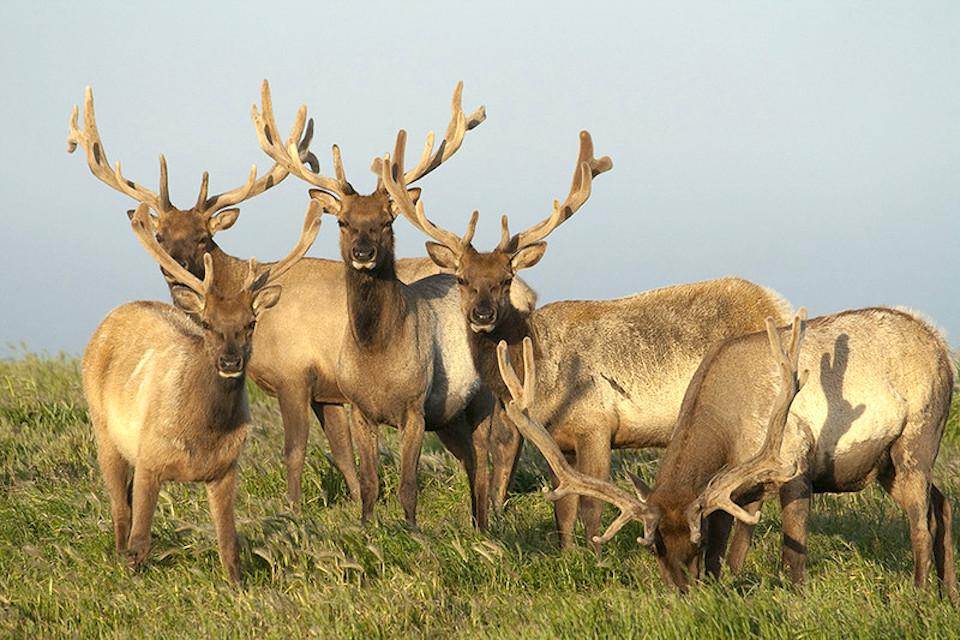
Critics say Tule elk are the scapegoats of a plan to support ranching at Point Reyes National Seashore/NPS file
In a decision that could lead to litigation, the National Park Service is moving to preserve the ranching industry at Point Reyes National Seashore in California for two more decades. While the hefty decision document calls for maintaining the seashore's free-ranging Tule elk herds, it also allows for the killing of elk near livestock operations.
Shortly after the final environmental impact statement was released Friday, the Center for Biological Diversity promised that "we're going to do everything we can to stop it.”
Ranching at Point Reyes dates to the late 1850s with the creation of beef and dairy operations. When the national seashore was established in 1972, the Park Service was given the authority to purchase the ranches from willing sellers, and then allow the operations to continue under leases.
But in recent years the ranch operations have drawn harsh criticism for impacts to the landscape and to the seashore's Tule elk herds. Tule elk are the smallest elk subspecies in North American and a California native. They had been extirpated from Point Reyes by the 1860s, but in 1978 the Park Service brought some back at the direction of Congress.
Today there are three herds at the seashore, Drakes Beach, Limantour, and Tomales Point. The one that park staff defintely would place a population cap on is the Drakes Beach herd because of its straying onto agricultural lands. At the end of 2019 that herd numbered 138 individuals, and the FEIS set a 120-individual limit on the herd, a cap that would be achieved through lethal methods, unless a way is found to move the elk outside of the seashore.
Groups that oppose ranching at Point Reyes, including the Center for Biological Diversity, claim the cattle and dairy operations, comprising 28,000 of the park’s 71,000 acres, negatively affect the environment (water quality, methane emissions, erosion, fish habitat), the infrastructure (pavement degradation from milk trucks) and recreational opportunities at the seashore.
In its 250-page final environmental impact statement, the Park Service acknowledged that the operations adversely impact the environment, stating that continued grazing would impact watersheds, generate greenhouse gases, and generate dust. Offsetting those impacts was the desire to "maintain the Point Reyes Peninsula Dairy Ranches Historic District and Olema Valley Dairy Ranches Historic District cultural landscapes," which are included in the National Register.
Some conservation groups, while supportive of the Park Service's 2012 decision to remove Drakes Bay Oyster Company from Drakes Estero in the seashore and convert the vacated land into wilderness, have voiced support for continued sustainable farming at Point Reyes. They've pointed out that the ranching families were instrumental in the authorization of the seashore in 1962 and that turning away from that relationship would threaten the creation of public land elsewhere.
Bob McClure, whose daughters are the fifth generation of his family in the dairy business at Point Reyes, told Traveler in 2016 that efforts to push the livestock industry from the national seashore put nearly 130 years of history at risk.
“We are concerned, but we have not packed our suitcases yet,” he said at the time. “I believe the park will continue to do what it can to support agriculture in the park.”
To the Center for Biological Diversity, though, the FEIS is weak in its support for Tule elk and other native wildlife and natural resources.
“This is a disaster for wildlife and a stunning mismanagement of one of America’s most beautiful national parks,” the Center's Jeff Miller said Friday. “The Park Service is greenlighting the slaughter of native wildlife in Point Reyes. After the elk, the next likely victims will be birds, bobcats, foxes and coyotes. This plan is illegal and immoral, and we're going to do everything we can to stop it.”
The FEIS would also allow for chickens, sheep, and goats to be raised at the seashore.
The National Park Service's Pacific West regional director could give final approval to the document in mid-October.



Comments
I'm in complete and violent agreement with you, Tom. What rouses my temper is that, even on NPT, we have a host of charlatans posing as conservationists and waving the "historic farming and ranching" banner.
We're now already in the beginning phases of that next mass extinction. We're way past the time for exhibitionistic agriculture in areas where we need the habitat and don't need the soil, water, and air pollution. And, that's not to mention the role of these commercial cattle and sheep herds at Point Reyes in hosting and nurturing Johne's disease and the resulting airborne spread of it to other wildlife and, potentially in the form of Crohn's reactions, to human visitors.